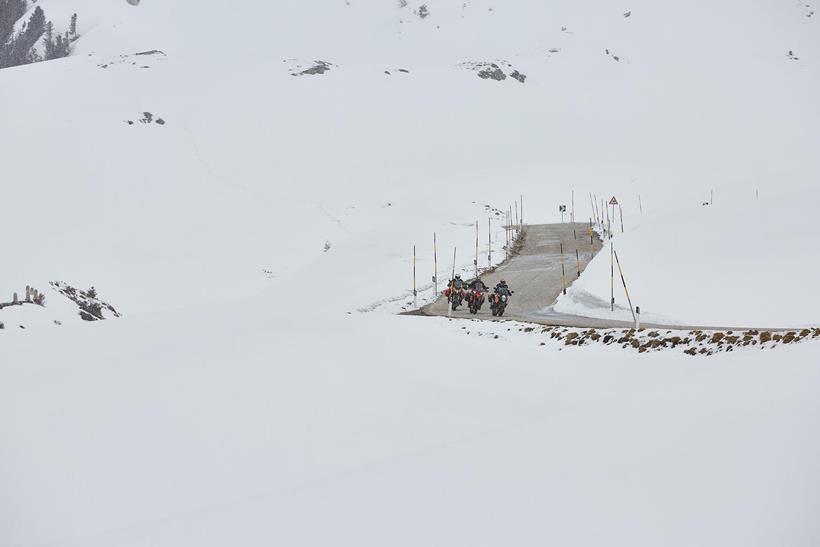Ice 'n easy: How to ride a motorbike in winter
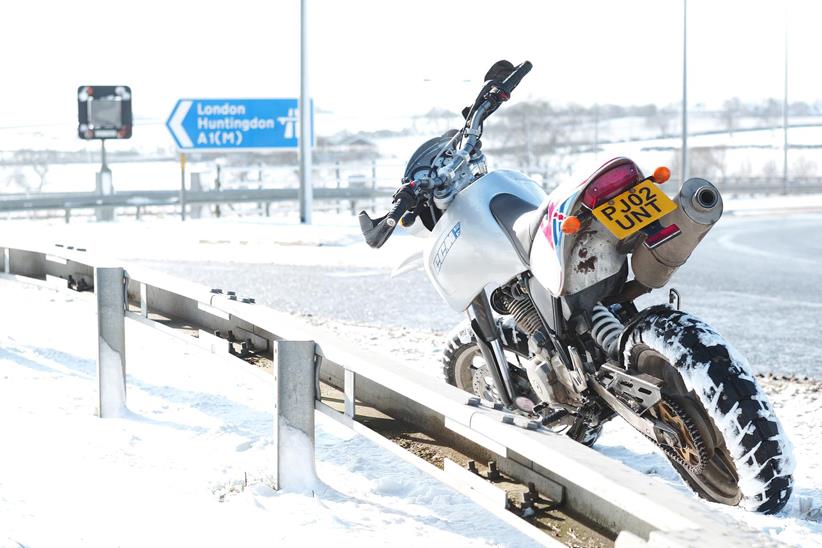
Learning to ride a motorbike involves getting a handle on dealing with various conditions. Biking all year round is one of the most life-enriching things you can do, and that includes riding a motorbike in winter. Yes – some people will think you’re mad; yes – you’ll have to wash your bike more in salty conditions and be more attentive to motorcycle maintenance; and yes – you might even get chilly. No, you don’t have to risk hypothermia: decent winter heated motorcycling kit can help on that front…
Jump to:
- 16 tips for riding a motorbike in winter
- How to prepare your bike for winter
- Our pick of the best winter riding gear
- FAQs
But the rewards are huge. So what do you need to think about when riding a motorbike in winter in the UK? We hooked up with the gurus at Rapid Training to get their 16 golden steps to riding in a winter wonderland (and guess what? Most of them apply to riding in rain, and every other season, too).
16 tips for riding a motorbike in winter
Beware of vision creep

Whether you’re in your first month riding or have been doing summers for years, switching to all-weather biking can present some different issues. Winter road surfaces can be wet, cold, and covered in slimy leaves, salt, or gravel that’s washed in from the verge.
Understandably, this barrage of hazards can make us nervous and it’s easy for our vision to come closer and closer to the bike with every potential problem we spot until we’re almost looking straight down rather than taking in all the information available. The trick is to do exactly what you would be doing in summer – use ‘rolling road vision’.
By continuously scanning ahead and updating your observation rather than fixating on any particular hazard you’ll have more time to process the implications and develop a plan of action.
No matter what time of year it is, the single most transformational thing you can do for your riding is to improve your ability to see and interpret detail at speed – and if you can do it in winter, summer riding will be a breeze.
Use the ‘So what?’ test
Having great observation is useless if you don’t use all that information properly. And in winter this means the ‘so what?’ test is more important than ever.
For example, if you’re barrelling along, look across some fields and see a right-hander ahead with overhanging trees and a van approaching, ask yourself ‘so what?’. It might mean the road is in shadow so there could be ice, even though it’s OK where you are.
So what? Obviously, you need to approach carefully, not just because you might lose traction, but because the van might, too. In this instance, your ‘so what?’ process might lead you to time your approach so the van takes the corner first while you hang back and see what happens.
Hunting for grip
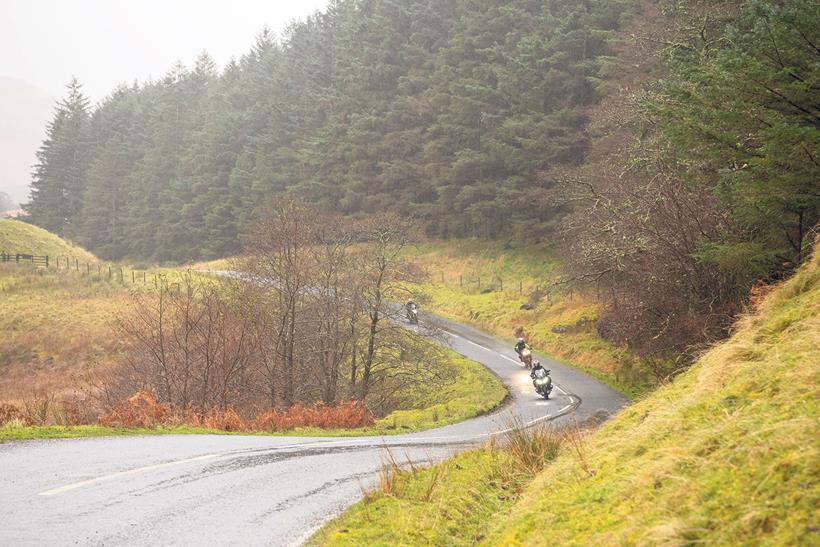
A novice rider will position themselves down the middle of the lane no matter what. A partially trained rider will robotically ride for position – for example, always hanging left on right handers to maximise vision through the corner.
But in winter, an expert rider will compromise the view to find the best traction available and adjust their speed accordingly. On a wet, slippery winter road you’re looking for the bits of tarmac with the most texture – ie not worn smooth by cars – or any dry bits, and you’re keeping out of the shadows where there might be ice lingering, even in daytime.
You’re continuously balancing being in the best position for view with where the grip is, and adjusting your speed accordingly. It’s complicated, but when this technique becomes intuitive you can ride surprisingly quickly on cold, wet roads.
Take regular breaks
With decent kit, most people can ride all day in freezing conditions provided they stop once an hour for five to ten minutes to get off the bike and get their body moving.
If there’s a café, it makes sense to have a warm drink, but if not, and you’re in the middle of the Lakes for example, just walk about and enjoy the view – it will set you up for the next hour in the saddle.
When you get back on the bike, you’re fresh. There is absolutely no point pushing on for two or three hours and getting really cold. Besides being dangerous, it’s also a deeply unpleasant experience.
Watch car exhausts
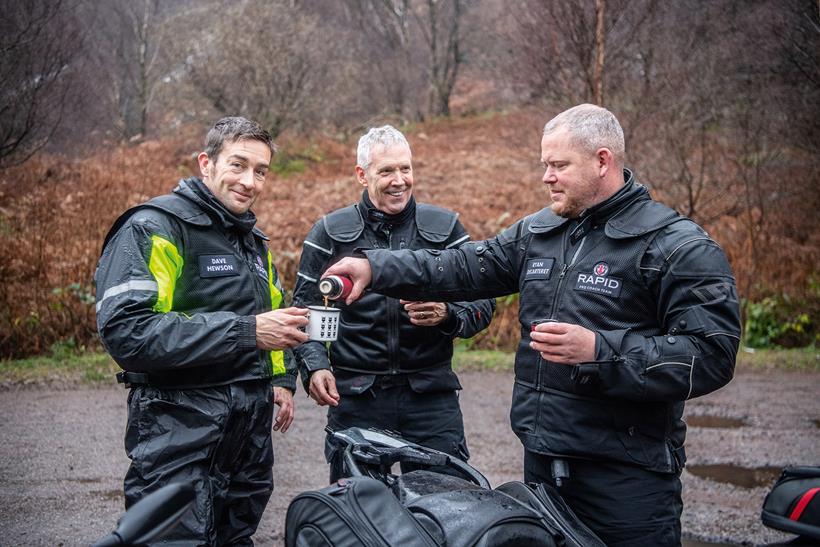
Cars with frosted windscreens and wing mirrors are a nightmare – not just because the drivers can’t see much, but because they’re distracted by trying to sort out the situation.
If you see a car billowing exhaust fumes, the chances are it’s just been started and should be treated with maximum caution.
Understand the cold
Getting chilled is a very bad idea on a motorcycle for several reasons. For a start, there are dozens of studies showing how your brain’s processing speed slows down when your body’s core temperature drops even slightly.
That’s when you start making bad decisions. Not only that but your body becomes tense, which makes it difficult to control the bike, and if your hands get cold your ability to brake and control the throttle are seriously compromised.
Every rider’s sensitivity to cold is different, but the symptoms to look out for are the same:
- Cold hands and feet: This usually means your body is moving blood to your major organs. Stop as soon as possible to warm up.
- Shivering: This is your body’s attempt to warm up and means you’re becoming properly cold. Stop as soon as possible.
- Shallow or slow breathing: You’re well on the way to hypothermia. Stop immediately.
- Loss of coordination, poor throttle control, confusion? Seriously risky. Stop immediately.
Check tyre pressures
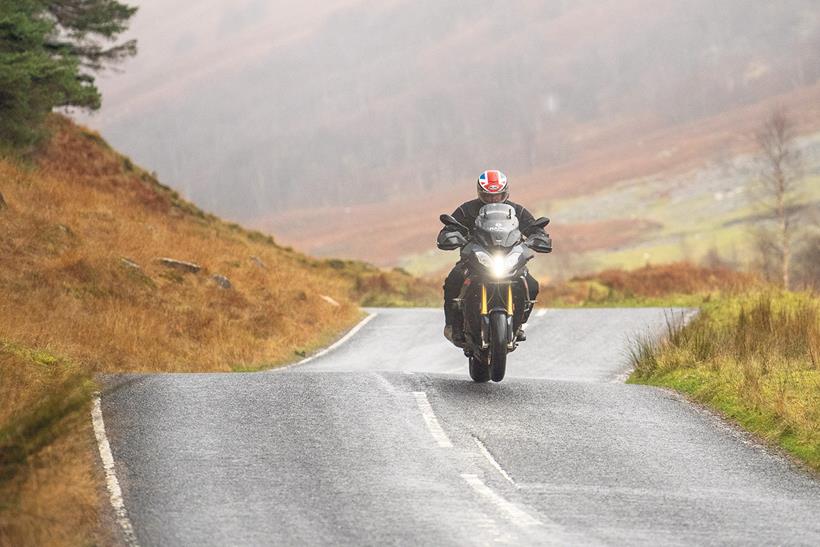
If it’s below 10°C, your tyre pressures will drop by 2-3psi, which doesn’t sound much but if your tyres were on the low side to start with this could be enough to make the steering heavy and give an unstable feeling on the brakes. Check them on cold mornings.
Beware low sun
If the sun is low and behind you – particularly if the road is wet and reflective – oncoming traffic will struggle to see you.
Look in your mirrors and if all you see is blinding glare, that’s what the oncoming traffic are having to cope with. Adjust your plan on the basis that they haven’t seen you.
Do a pre-ride draft check
Yes, you need layers and waterproofing, but many riders forget about sealing around neck, cuffs and waist closures more effectively. Freezing drafts don’t just undo most of your insulation efforts, they’re dangerously distracting so it’s important to sort them before you set off on your ride.

It’s all about your front brake
The old-school advice was to brake using 50:50 front and rear in the cold and wet but with modern bikes and tyres that’s nonsense.
The front brake is the main brake in winter, just like it is in summer. You should always be smooth on the brakes, but it’s more important when it’s slippery – load up the front progressively, but not slowly, and get as much weight as possible over the front for maximum braking.
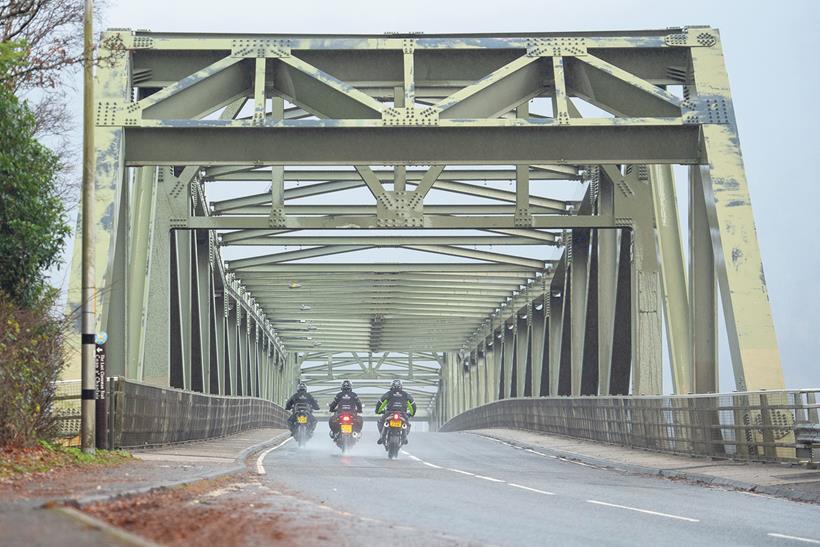
Be ready to move
Most of the time in winter you won’t need to move your body because you won’t be carrying enough lean angle to make it worth bothering, and shifting about might unsettle the bike.
But you need to be ready to move and be prepared to take your weight on your feet so you can shift about if necessary. In winter, it’s usually tight corners and roundabouts where you need to think about your body position.
Here, nervous riders often lean their body away from the bend, pushing the bike down beneath them. This is an error, because it means the bike is carrying more lean, and is at more risk of sliding. In those situations, it pays to smoothly drop your upper body towards the inside of the corner so the bike doesn’t have to lean as far.
Check for shadows
If it was frosty first thing, look for shadows. Even if it’s warmed up by the time you’re out riding, ice can linger all day out of the sun.
Pick the right line
Minimising lean angle is crucial in winter, yet many riders don’t straighten out bends and roundabouts where they could do safely. Straight-lining roundabouts has the added advantage that it keeps you away from the edges where diesel is most likely to have sloshed out from cars and trucks.
Also, consider squaring off tighter corners by taking a straighter line in, slowing down more than usual, turning the bike, and then lifting it up to drive out. This reduces the time you spend leant over, yet in our tests proved quicker than taking the traditional long sweeping line.
Know your friction coefficients
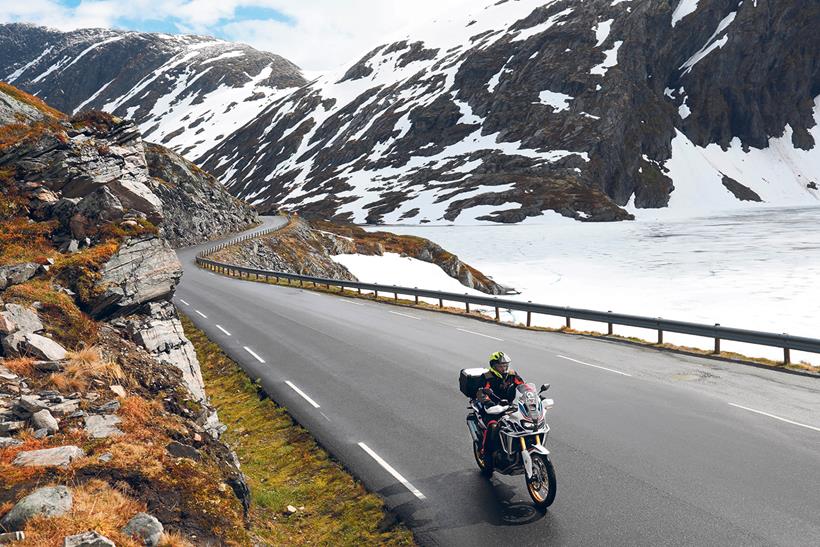
Most riders are over-cautious in the wet. On a good dry road the coefficient of friction (COF) will be around 0.7 – this is a ratio of how much sideways force is required to move a block compared to its weight.
If the road is wet, the COF would be about 0.5. If it was icy you’d get about 0.1. The drop-off from 0.7 to 0.5 is just under 30 percent, but most riders’ speed reduction is much greater than that – you don’t have to slow down as much as you think – unless it’s icy, in which case you need to slow down a huge amount. Don’t forget that black ice is harder to spot than white ice, too.
Ride, ride, ride!
Skill-fade will be very significant if you don’t ride in winter. Use the dodgy conditions as a chance to hone skills that will make you faster and safer once the roads dry out and the sun reappears. You’ll especially feel the benefit when negotiating summer showers.

Get some training
If you live in the UK and you’re not confident in poor conditions, you’re missing out on a huge amount of riding.
Decent training could transform your winter, spring, summer and autumn enjoyment on two wheels. It’s not as expensive as you might think (certainly cheaper than that shiny end-can you keep looking at online), and it’ll transform every single mile you ride, all year, forever.
Don’t ignore the obvious
- Good kit Multiple thin layers are better than a few thick ones, non-motorcycle specific thermals work fine, and heated kit is an absolute godsend. Getting wet sucks out heat, so keep your outer layer coated with a fabric waterproofer. If you’re going a long way and it’s going to be wet, carry spare gloves and socks.
- Good vision Make sure your visor is clean and scratch free, and always carry a visor cleaner in winter. Products such as Nikwax Visor Proof help rain and dirt roll off your visor. Pinlock visor inserts are a must.
- Be smooth In winter you don’t have to ride gently, but you must be smooth. Throttle, brakes, and steering all have to be controlled with a velvety touch.
- Look at the forecast Especially important if you’re heading anywhere hilly – higher ground is usually colder, so 5° in the valley can mean -1° and black ice up on the passes. It’s also worth having a Plan B in case the weather turns nasty.
![]()
How to prepare your bike for winter
How do you protect your motorbike from the cold? Preparing your bike for the colder weather, salt on the roads and slippery conditions is an important task if you don’t want to watch it rot away in front of your eyes. As well as the tips in this page, make sure you wash your motorbike regularly throughout the winter time, too.
Make sure your bike can cope with the impact of cold weather on motorbikes and scooters these 10 steps…
1. The right rubber
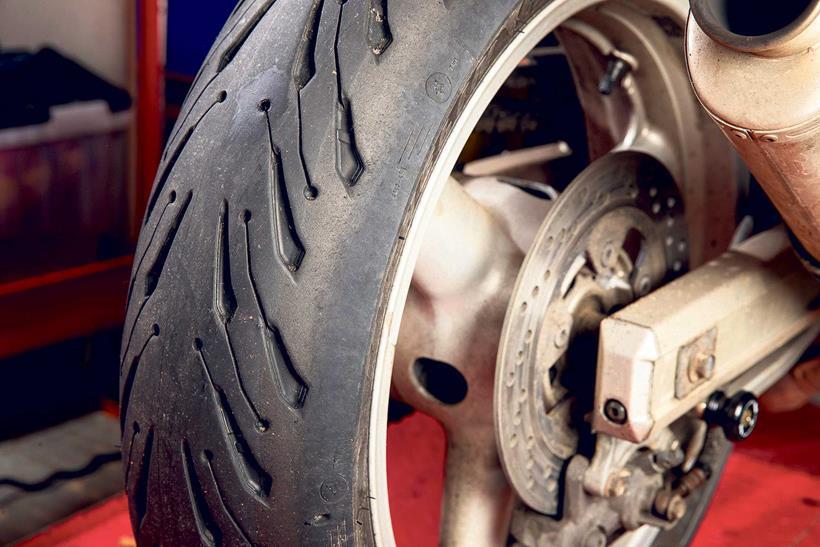
Cold conditions affect how tyres work and dedicated sports rubber isn’t suited to winter. Temperatures below 10 degrees are the domain of silica-based sports-touring tyres. If you have suitable tyres already, check their condition, especially the tread depths. And bear in mind that even if they are legal, they may still need changing.
2. Check you’re up to pressure
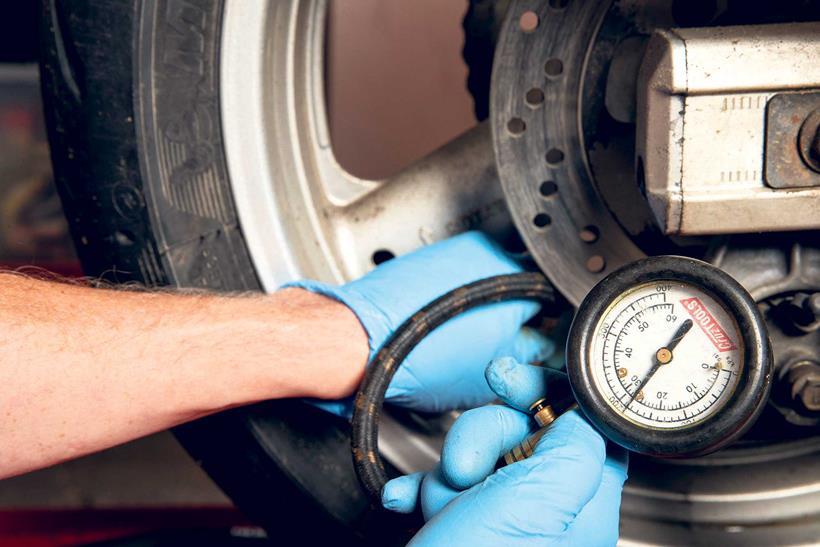
British weather fluctuates wildly, so check your tyre pressures at least once a week. Air expands by roughly 2psi for every 10°C increase in ambient temperature and contracts by the same value when temperatures fall. So if you last set your pressures in July’s 30°C heat you will find that they’ve dropped by 5.4psi on a frosty 3°C November morning.
3. Battery health check

Low temperatures cause oil to thicken and an engine’s internal components to drag, so your battery has to work harder in order to crank over the motor from cold. With the engine off, check the battery’s resting voltage: a battery in good condition should indicate a reading of at least 12.6v. Lightly grease the battery’s terminals and check all the connections are tight.
4. Don’t get frozen out
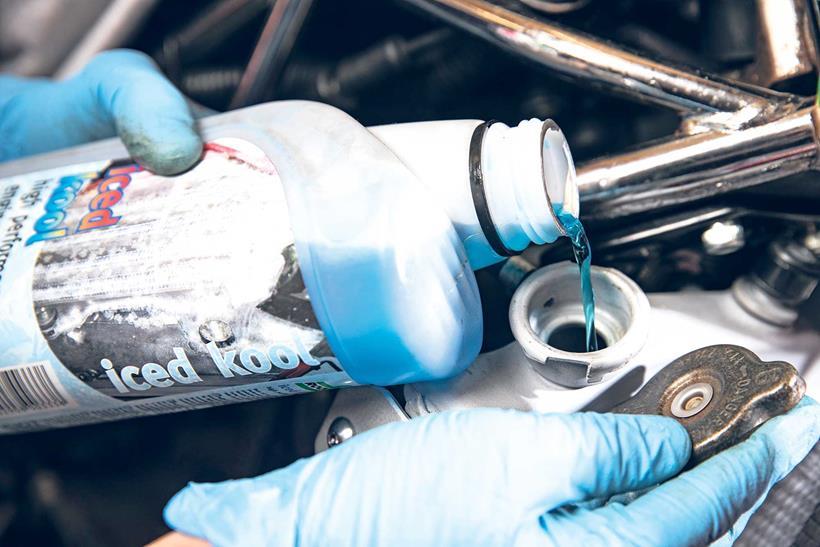
Never be tempted to top up your radiator with water rather than proper coolant that has anti-freeze properties. And check how long the coolant has been in the system because its freeze-beating properties degrade over time and if your coolant freezes it will wreck your engine. Owners of air-cooled bikes needn’t worry about this step, of course.
STICK’S TIPS: Change your coolant every two years to keep it working at its best
5. Burning bright
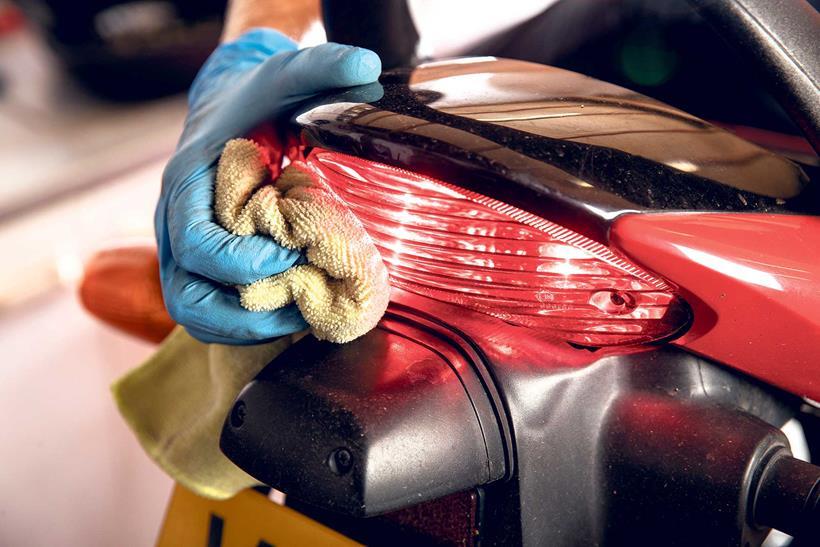
Make sure your lights are working and not covered in crud. Adjust headlights for both dip and main beam for optimal performance. If you’re thinking of adding lighting accessories such as front fog lights or LED indicators make sure you choose quality items.
6. Warm hands, happy heart
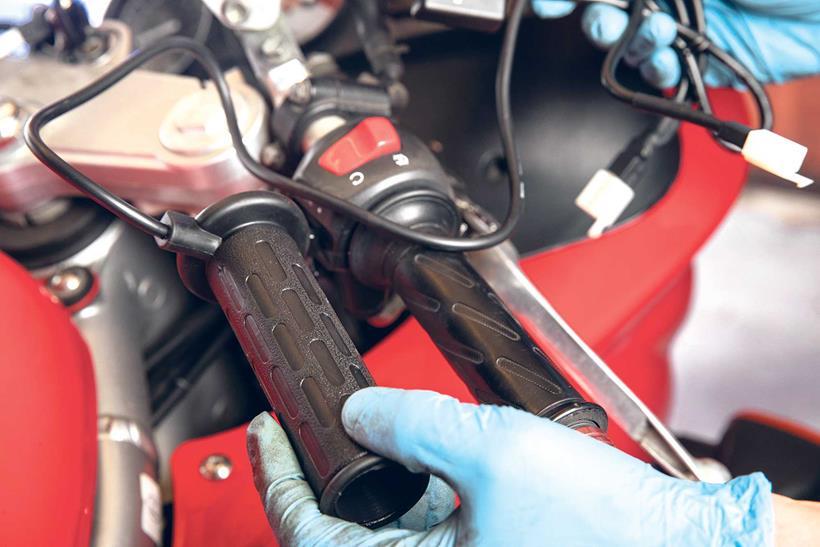
Heated grips will take the pain out of winter rides. The grips have heating elements imbedded in them, often with multi-levels of heat control, and are powered via the bike’s 12 volt electrical system.
7. Lube it or lose it
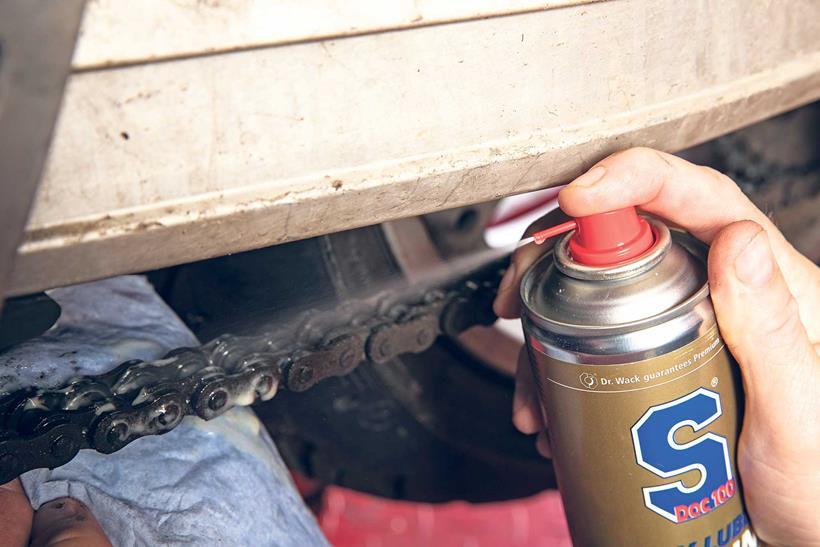
Winter salt will destroy your chain in double-quick time so stay on top of cleaning and lubing. Alternatively you can fit an autolube system such as a Scottoiler. These devices automatically meter a precise amount of oil to the chain, and they work so well that they can substantially extend the life of your chain and sprockets.
8. Vision technician
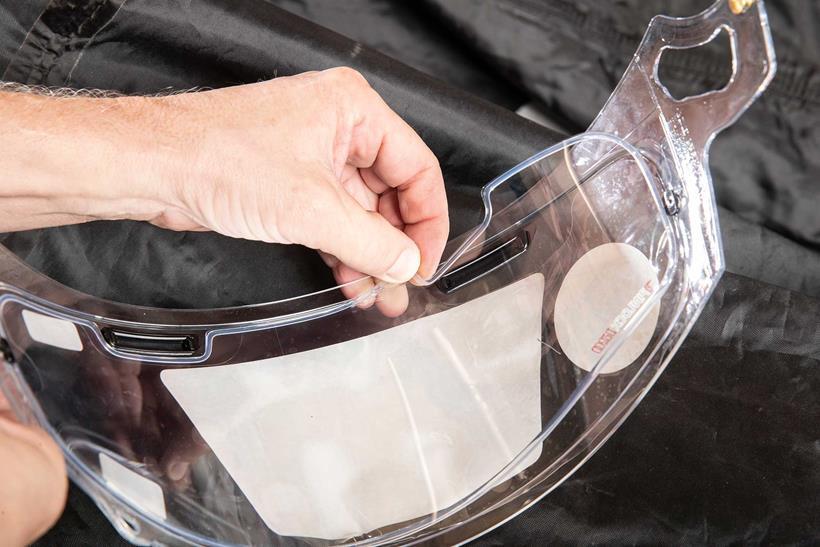
Cold and wet conditions mean visors are prone to misting. The best solution is to fit an anti-fog insert into your visor. A Pinlock insert costs around £25 and will be a revelation if you’ve never used one before.
Alternatively, there are liquid treatments for the inside of your visor but these will need regular re-applications for decent performance.
STICK’S TIPS: Remove the insert and wipe it over with a microfibre cloth regularly
9. Smooth operator
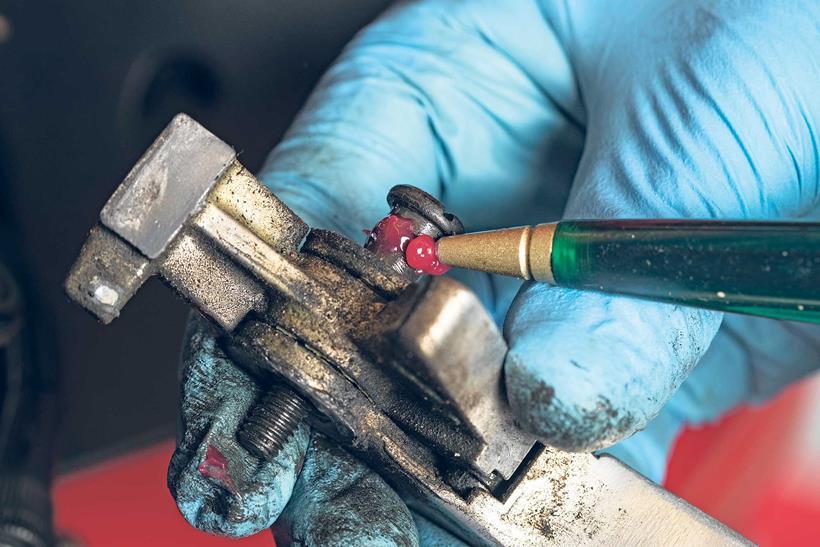
When your hands are cold and the conditions challenging, you need your bike’s controls to be as smooth as possible. Remove the front brake lever and give the pivot bolt a thorough clean using wet and dry or a wire brush to remove any corrosion. Then re-install it with a thin smear of grease. The same can be done for the clutch lever, and rear brake levers.
10. Relegate rust
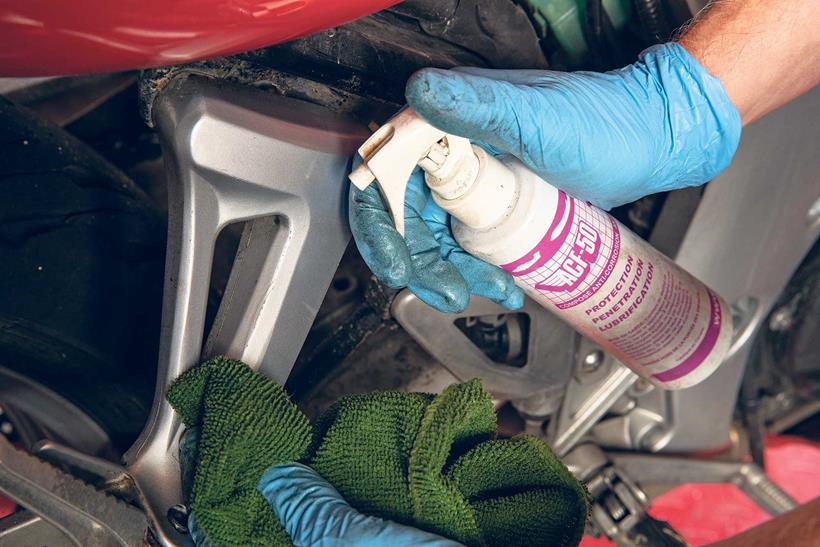
Using anti-corrosion products like ACF50 or XCP Rust Blocker will protect your bike from salt-accelerated corrosion. These products coat the vulnerable parts with a fine film which acts as a barrier to prevent oxidisation taking place. You should use anti-corrosion products alongside an established cleaning routine for optimum performance.
Winter riding gear
Our bike kit section features loads of gear for winter riding. The best heated motorcycle clothing feature is the first place to check, and we’ve also set out our pick of the top winter jackets to consider, alongside the best heated jackets.

Keeping your tyres in good condition is also an important factor in all conditions, but all the more so in winter. Get everything you need in our motorcycle tyres area.
Common winter riding questions
How long should I warm up my motorcycle in the winter?
You should always warm your bike up a little in cooler weather just to get the oil hot. Otherwise, if you start revving your engine cold you could risk damaging some of the internal parts. You only need to do this for 10-20 seconds, though – there’s no need to sit there for minutes annoying your neighbours.
Why does my motorcycle take a while to start when it’s cold?
The oil will be thicker when cold, so there’s more friction and hence it’s harder to turn over. Be patient and give it a moment or two to get the oil flowing.
